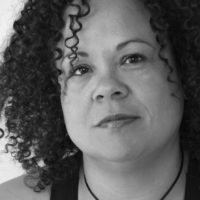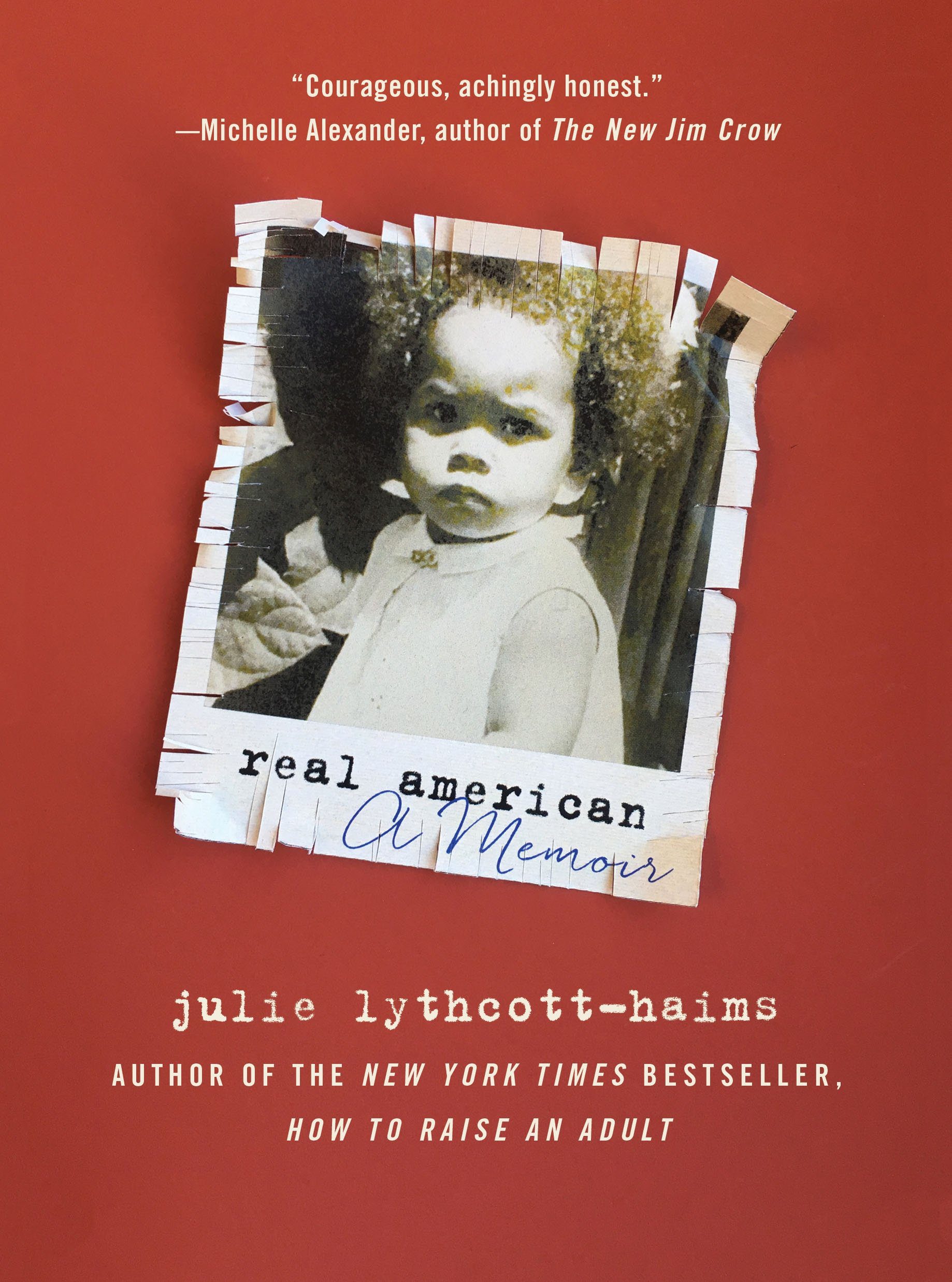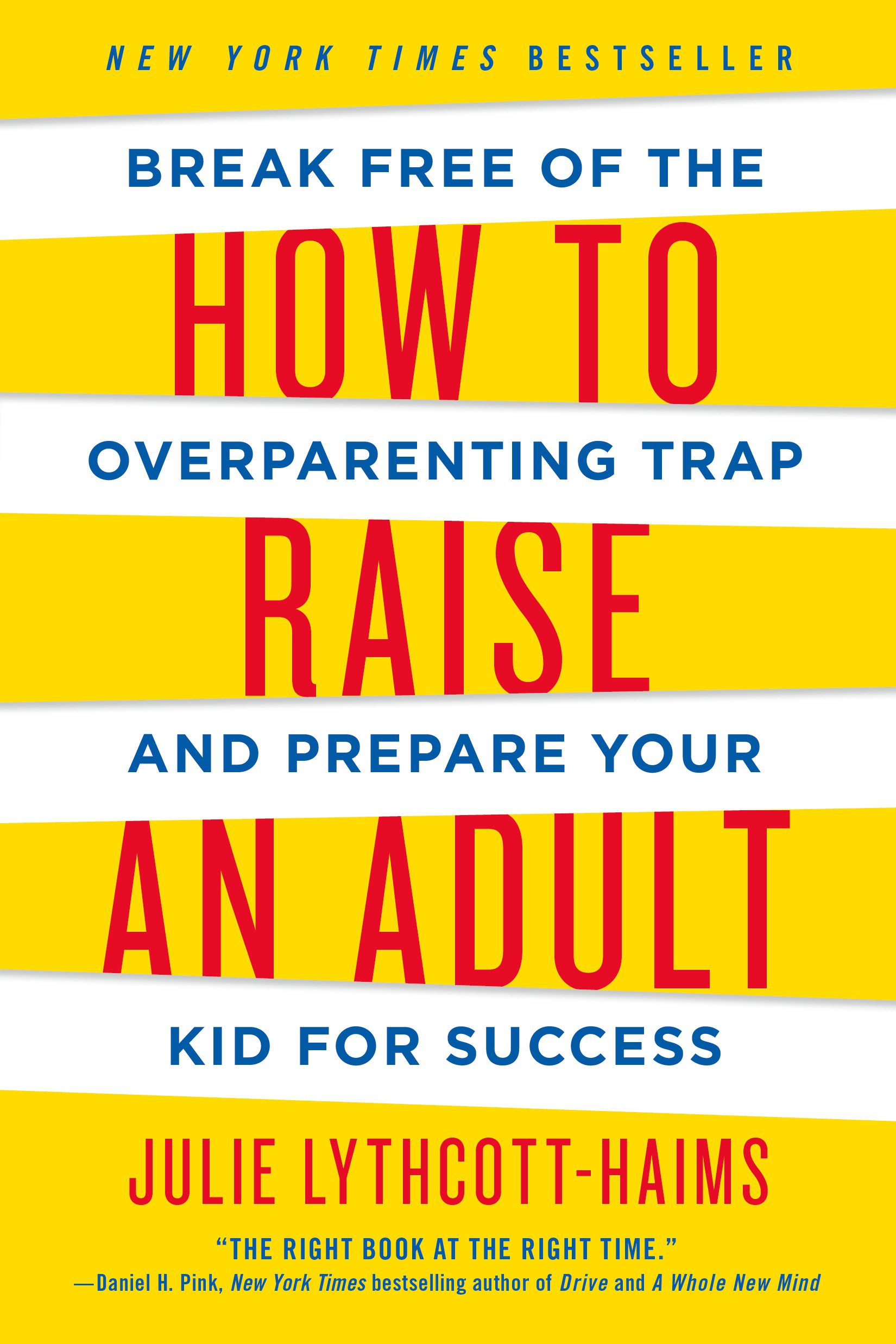I first met Julie Lythcott-Haims at the San Francisco Writers Grotto, a co-working community of authors with a history stretching back twenty-four years. Julie’s compassion, intelligence, and enthusiastic support of other writers immediately impressed me. After I read the galleys of Real American and Julie’s first book, the bestselling How to Raise an Adult, her extraordinary range also amazed me. Julie pens what she calls “straight up nonfiction,” prose-poetry, and traditional memoir all powerfully. Her work takes many forms but has a single aim: helping human beings thrive and exploring what gets in the way.
How to Raise an Adult grew out of Julie’s decade-long tenure as the Dean of Freshmen at Stanford University, where she became concerned that “helicopter parenting” was preventing young people from developing agency. The book was published in 2015 to critical acclaim and has become the subject of an immensely popular TED Talk. Julie is a highly sought-after speaker with appearances on CBS This Morning, The Today Show, and CSPAN. Her work has been published in the New York Times, Slate, the Times Literary Supplement, the Chicago Tribune, and elsewhere.
In Real American, Julie tackles a more personal subject: her experience as a Black and biracial person suffering from low self-esteem as a result of racism in its myriad forms. The memoir also chronicles her journey to self-acceptance. Real American recently won the 2018 PEN Oakland Josephine Miles Literary Award.
I was happy to have the chance to talk with Julie about her two books, her evolving work as an author and advocate, and what being an American means to her in these politically turbulent times.
***
The Rumpus: Tell me about your professional evolution. You started as a corporate lawyer, then became the Dean of Freshmen at Stanford University. What made you decide to leave those two worlds behind and embark on a third career as a writer?
Julie Lythcott-Haims: Some may think of me as a dilettante. But I’m more of a seeker than a dabbler, and what I’m seeking are ways to alleviate pain. I aim for really good rather than great, and I hope to grow rather than to become; these freedoms give me the room to move from one world to the next without fear of losing some part of me to what I’ve left behind.
To the specifics of your question: I went to law school to become a voice for marginalized people. But I was young and insecure and the approval I desperately needed from others seemed to come from landing a corporate job. So I took a corporate offer out of law school instead. Then quickly realized it was not the right kind of work for me. I might have circled back around to the public interest work that had taken me to law school in the first place, but I feared I’d be seen as a sell-out by those organizations. Besides, by that point I had started to fall out of love with law. So instead, I chose a new path: working with students at the university level. As dean, I grew alarmed by the number of students still effectively on a leash held by their parents. They lacked self efficacy, which leads to anxiety and depression, and I wanted to write a book about that pain. I enrolled in the MFA program at California College of the Arts to get great mentoring, and to develop some confidence as well as some chops. I researched and wrote How to Raise an Adult while I was there. It was my side-gig in a program otherwise devoted to the study of poetry, creative nonfiction, and a bit of playwriting.
Rumpus: Let’s talk about your latest book, Real American, which describes your experience as a Black and biracial woman who battles low self-esteem stemming from racial microaggressions, as well as full-throated insults. Importantly, it also traces your journey to self-acceptance. What was the spark that inspired you to write this memoir?
Lythcott-Haims: The earliest version of what would become Real American came into being during my first semester at California College of the Arts in a poetry class taught by Joseph Lease. Joseph assigned a collection of Hannah Weiner poems written in multiple typefaces depicting voices Weiner accessed through clairvoyance. In response, I wrote a polyvocal poem in seven voices about my experiences with racism and self-doubt in high school, called “A Day at the Races.” The voices were my ego, my id, my super-ego, my mother, my father, my best friend, and the town. It was the first and only time a professor told me unambiguously, “Publish this.” So I went for it. I ended up placing “A Day at the Races“ in a startup literary journal called As Us founded by a group of indigenous women who were willing to see a kindred spirit in a Black girl who grew up in a white town. It was also accepted into San Francisco’s Poet’s Theater in 2013, produced by Small Press Traffic and directed by Brandon Jackson. “A Day at the Races” showed me that I just might be able to write about race and racism in a useful way.
In a more practical and urgent sense, however, my chair was pressuring me to graduate which meant producing a thesis. I was in year four of a two-year program, having slowed way down to write and then tour How to Raise an Adult (which to my mind was not an important enough work to serve as a master’s thesis), and frankly simply loving being back in graduate school in my forties. I didn’t want to leave! So I threw almost everything I’d written over those four years into a document, and hoped for the best. My thesis committee—the novelist Juvenal Acosta and the memoirist and CNF maven Faith Adiele—didn’t buy it. “You’re writing well about race,” they told me. “Get rid of the other stuff,” (I think they meant crap), “And augment the race stuff, and maybe you’ll have something.” Three months later I graduated, with a draft of Real American.
Rumpus: I’m intrigued by the form of Real American, which has been characterized as a memoir written in prose poetry. How did that hybrid come about?
Lythcott-Haims: As a biracial person, my very existence lies outside of the conventional boundaries used to organize and order humans. Genre is another human-made construct whose traditional boundaries seem to be round holes for my square peg. (I study and write poetry but I am not a poet—I study poetry to get better at choosing words; I study poetry to make my prose and oratory stronger. I’m interested in questions like, “Are fictional stories rooted in human experience untrue?” And, “Just because we call something non-fiction how do we know it’s true?” And “What is truth, anyway? Who decides?”) When the CCA faculty invited David Shields to present on his then-latest book Reality Hunger, it felt like manna from heaven; here was permission to ignore genre and let my writing be what it needed to be to support the idea I was trying to manifest on the page. In elucidating the inadequacy of genre classifications, Shields writes, “Anything processed by memory is fiction.” I write memoir believing what Shields says to be true, and being perfectly okay with that.
Like “biracial,” the terms “prose-poetry” and “creative nonfiction” are relative newcomers to our lexicon and offer a home for those of us doing something misunderstood or not valued by those who revere traditional categories. Because Real American contains some pages of poetry amidst the prose, as well as entire paragraphs whose prosody aims to create speed and impact, “prose-poetry” was an appropriate classification for Real American. “Creative nonfiction” also applies to this work, in that I deploy various techniques including an atypical form (margins, page breaks, and chapter headings) in an attempt to offer readers a “true story well told.”
Rumpus: In Real American, you talk about celebrating the quintessential American holiday of the Fourth of July, as well as taking part in typical American barbecues and pool parties. How did these events fit into your journey toward self-acceptance?
Lythcott-Haims: I was an American kid who loved the rituals of Americana. Those were the years when I didn’t know I was Black, meaning I didn’t know that I and my ancestors were the villains in the American narrative. As I grew to understand what America makes of Black people, I became less patriotic. It’s complicated to pledge allegiance to a flag or sing an anthem representing a country that has never wanted or valued you.
Rumpus: You also write about hair in this book, getting bad and good haircuts, being teased for your “tumbleweed” hairdo, and using a curling iron throughout your childhood and young adulthood to straighten your hair. Why is hair important?
Lythcott-Haims: Hair is everything to Black women, and to many Black males, too. At school and in the workplace, we are often told our hair is ugly, inappropriate, unclean, or unprofessional. (Case in point: The Black teenager from New Jersey who made headlines recently because a wrestling referee forced him to cut his dreadlocks in order to compete in a tournament.) Paradoxically, in these same spaces, often white folks can’t help but reach out and touch our hair as if we’re some kind of object on display or an animal in a petting zoo. So, because hair matters so much to Black folk and has mattered a great deal in my life, hair is a motif in Real American and stands for the outward manifestation of my psychological well being. The more self-loathing I experienced, the straighter I needed my hair to be. As I started to accept myself in my mid-thirties I was able to wear my hair the way God gave it to me: cascading corkscrews. Now that I’m in my fifties, my hair is thinning, and I mourn the hair years I lost by tamping down those fabulous curls. I can’t get those years back and I may never get those curls back. I may have to go the route of many of my sisters and get a weave or a wig in order for my hair to continue to represent the unambiguous love I finally feel for my Black self.
Rumpus: What was the process of writing Real American like? Did you experience particular moments of healing or sorrow?
Lythcott-Haims: Writing this memoir was a process of me saying to myself, “This happened and it was painful and now we’re going to tell people about it.” And the effort to pull these memories out of their hiding places in my subconscious, and organize them in ways that would work on the page was healing to a great extent. But some of the memories that came back up were about my own regrettable or even shameful behaviors. I winced at having to put those on the page, and in summoning them back to consciousness I re-experienced some of the original sorrow. The book has also been a bridge back to folks who had hurt me, a way to say, “Hey this is how it felt to be me when you said what you said or did what you did.” To my relief, most of those folks have taken the whole thing rather well, but I re-experienced some sorrow when those interactions did not yield the kind of reconciliation I might have hoped for. I have to say though that the greatest moments came not while writing but while touring the book, which I continue to do. Readers come to the book-signing line and say they no longer feel alone, and I grasp their hand and tell them that I wrote this book for all of us.
Rumpus: After having written this book, what do you believe it means to be a “real American”?
Lythcott-Haims: I’ve always maintained that it’s a redundancy—that the noun “American” does not need to be modified by the word “real.” But Sarah Palin and Donald Trump and the like began using this terminology some years ago to try to create a distinction between those whom they felt deserved access to America’s bounty, and those whom they felt did not (i.e. Black and brown people). So, I titled the book Real American to reclaim that term for all of us. I also dedicate the book to my great-great-great-great grandmother Sylvie, a slave, who was considered three-fifths of a human when they wrote the Constitution but who is one hundred percent whole to me. She made me a seventh-generation American, which I believe makes me (and by extension all descendants of African slaves in America) extremely “real” in our American-ness.
Rumpus: Your first book, How to Raise an Adult, has been described as an “anti-helicopter-parenting” manifesto. The book is full of wisdom, but of a very different kind than Real American. Your experience as the Dean of Freshmen at Stanford University was clearly one of the reasons you wrote this book. What were some others?
Lythcott-Haims: I began as a finger-wagging dean who wondered what the hell was up with so much parental involvement in the day-to-day lives of college students and why the students didn’t seem to mind. And then one night I came home for dinner with my own two kids and started cutting my ten-year-old’s meat. Suddenly I realized I was going to be one of those parents who wouldn’t be able to let go of my eighteen-year-olds when the time came. So, the book blends my personal narrative with my narrative as a concerned dean. I think it lends a more compassionate and compelling tone to a book that might otherwise come across as quite critical. In other words, I’m the problem I’m writing about. It’s been extremely humbling to learn and learn and learn again what a great example of helicopter parenting I am.
Rumpus: How to Raise an Adult was a New York Times bestseller and gave rise to a TED Talk with three and a half million views and counting. What do you think has attracted so many readers and viewers?
Lythcott-Haims: I think there’s an inescapable truth to the message, like that of the child who dared to say the emperor had no clothes. In the first six months I was touring with the book, the audience questions veered toward the defensive, i.e. “Yeah, yeah, yeah, but aren’t we just doing what we have to do to get our kids to the right college?” Close to four years after publication, I don’t get that kind of reaction so much anymore. The mental health problems facing so many children, adolescents, and young adults are correlated with over-parenting, and almost everyone seems to know someone for whom this is entirely true. The question I get most often now is, “Yep, you’re completely describing me, my kid, our school community, whatever. What do we do about it?” I wrote this book to help kids, so I find these moments of acceptance on the part of parents incredibly heartening.
Rumpus: As I’ve previously mentioned, your books How to Raise an Adult and Real American are quite different. What would you say they have in common? What do you think makes them differ?
Lythcott-Haims: They both address an obstacle in the path of humans trying to thrive—over-parenting on the one hand and racism on the other. In both, I’m empathizing with those at the mercy of a larger system and I’m advocating for removal of the obstacle. I’ve rooted for the underdog since I was a young child, and I think both of these books try to do that.
Also, they both turned out to be vehicles for me to be vulnerable with readers, which is a central aspect of my life practice these days—to go toward revealing vulnerability rather than fronting.
What’s different? How to Raise an Adult is the conventional first-born. Real American is the quirky younger sibling. My publisher hadn’t bargained for its unconventional margin, font, page breaks, and lack of hyphenation at the end of right-justified lines. I had to fight for every aspect of the form—it felt like I was defending my child’s right to be. Finally, I asked them to just pretend it was a book of poetry and figure out how to translate my Word document onto the page exactly. And in saying this, I return to the similarities between the books. I was told I couldn’t have footnotes in How to Raise an Adult. I was told people wouldn’t read them. I didn’t care. The lawyer in me insisted that this well-researched book was going to be a map to any further research a reader might want to do. We compromised at end-notes. Seventeen pages of them.
Rumpus: What’s up for you next, writing wise?
Lythcott-Haims: I’m working on a few small projects but the major iron in the fire is a sequel to How to Raise an Adult, which we are tentatively calling How to Be an Adult. It’s a narrative-forward approach to what it means to inhabit an adult life, told by dozens of interviewees. Po Bronson employed that style in his seminal work What Should I Do With My Life. I think it will also work well for the book I have in mind. (If you know a twenty-or thirty-something who knows that they are an adult and can articulate how they know it, please send them my way.) I hope this book will be received as a compassionate, encouraging, offering to those struggling with whether and how to “hashtag adult.” There is pain in the un-knowing, and more than anything I want to help heal it. I root for humans just trying to make their way.






